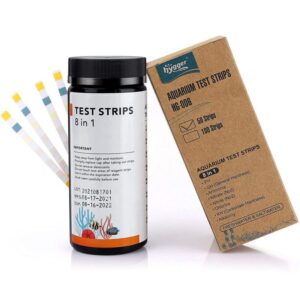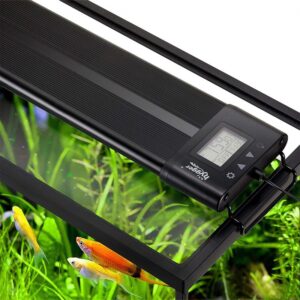Belonging to the Callichthyidae family, corydoras are freshwater catfish and can be found in South America. They are small fish and can reach 1-4.7 inches and they can live up to 10–15 years in captivity or even longer under optimal aquarium conditions. Also, the body armour plus sharp and venomous spines prevent fish from attacking by predators. Here is this article, let’s explore further and understand more about types of corydoras, stocking density, and tank mates of corydoras.
Content Table
Types of corydoras
Types of cory catfish
Actually, there are a surprising amount of corydoras types. And we will list some in the table below.
| Panda corydoras | Corydoras metae | Salt and pepper catfish | Corydoras adolfoi |
| Bronze corydoras | Corydoras trilineatus | Leopard catfish | Corydoras arcuatus |
| Pygmy corydoras | Corydoras agassizii | Banded corydoras | Corydoras similis |
| Corydoras paleatus | Green gold catfish | Corydoras pantanalensis | Xingu corydoras |
| Sterbai corydoras | Corydoras amandajanea | Corydoras atropersonatus | Elegant corydoras |
| Corydoras julii | Corydoras melini | Corydoras acrensis | Albino corydoras |

How to take care of Corydoras
1. Corydoras tank requirements
Corydoras are easy to keep in aquariums. They are originally from shallow and slow-moving water. Also, they prefer soft and acidic water. Commonly, corydoras can be kept in a minimum tank size of 10–20 gallons. Given below are the requirements of water parameters.
- Water temperature: 74-80℉
- pH level: 7.0-8.0
- Water hardness: 3-10 dKH /54-180 ppm
- Ammonia level: 0 ppm
- Nitrite level: 0 ppm
- Nitrate level: no more than 40 ppm
By the way, it is necessary to keep optimal nitrate levels. Because high nitrate levels would cause barbel infection. Accordingly, testing the water parameters regularly is critically crucial.
2. Corydoras tank set up
Plus, gravel or aquarium decor with sharp edges would bring bad effects on corydoras catfish. As for aquarium substrate, sand or gravel without sharp edges can be an excellent alternative. You can keep the substrate half an inch or less in-depth, which allows Corydoras to dig into the bottom of the tank.
Aside from that, corydoras like tanks with aquatic plants. While the aquatic plants provide shaded areas for corydoras, plants are also helpful to improve the oxygen level and ornamental value. The available plants can be Java moss, Java fern, or some other floating plants.
3. Necessary aquarium equipment
Most corydoras prefer low light. However, you should make sure of optimal lighting for aquatic plants in Corydoras tanks. So, whether should you add an aquarium light depends on the status of Corydoras tanks. If there are plants in the tank, it is better to add a planted aquarium light, which helps to photosynthesize and enhance plants’ colors.
Moreover, corydoras are sensitive to water quality. Poor water quality would trigger health issues. As a result, it is better to build a great filtration system. For instance, you can add a canister filter. Featuring a 3-stage filtration system with the wave, aeration, and adjustable flow, the canister filter is ideal for 5–30 gallons fish tanks.

What do corydoras eat
Most corydoras are bottom-dwellers. They often search for food in sand or gravel. Actually, corydoras are omnivorous, and the available foods include debris, algae, uneaten food, insect larvae, insects, worms, dead fish, pellets, flakes, and vegetables.
Furthermore, corydoras are diurnal and become active during the day. Thus, you can feed them during the daytime. Commonly, it is feasible to feed them once or twice each day. And you should make sure Corydoras can finish eating without about 2–3 minutes.
Additionally, corydoras make sense in tank cleaning. They will eat uneaten fish food on the substrate. While they also consume algae in aquariums. Consequently, adding corydoras is beneficial to keep great water quality.
How many corydoras can be put in a tank?
Corydoras are peaceful. Most corydoras like to live in groups, and they should be kept in a school of four or six. As we have mentioned above, the minimum tank size of corydoras is 10–20 gallons. In 20 gallons corydoras tank, you can keep 8-10 corydoras. The fish density is determined by the corydoras types. Specifically, if you plan to keep small corydoras in a 20 gallons tank, like pygmy corydoras, then you can keep up to 14 pygmy corydoras in the tank. Given below are more examples.
| Tank size | Recommended fish quantity |
| 10 gallons Corydoras tank | 1-6 Corydoras |
| 20 gallons tank with corydoras and tetras | 4 pygmy corydoras and 3 neon tetras |
| 30 gallons tank with panda corydoras | 12-18 panda corydoras |
| 30 gallons tank with pygmy corydoras | 8-15 pygmy corydoras |
| 50 gallons tank with albino corydoras | More than 20 Albino corydoras |
Corydoras catfish tank mates
Peaceful corydoras can be a great addition to most community tanks. For example, tropical freshwater community aquariums. Cardinal tetras, bettas, and guppy fish are excellent tank mates for corydoras catfish. In addition, shrimp or snails are other options, like Amano shrimp, ghost shrimp, Red cherry shrimp, Mystery snail, Nerite snail, and Malaysian trumpet snail.

Take pygmy corydoras as an example, peaceful and small fish can be good tank mates for corydoras catfish. Alternatively, aquatic pets of similar sizes are great. For instance, you can keep them with Neon tetra, Zebra danio, Guppy fish, Molly fish, etc.
Odd corydoras behavior
Corydoras can breathe in the air and water. Consequently, they can survive in the face of low oxygen levels in fish tanks. However, if they breathe in the water surface frequently, it may be a signal of poor water conditions. Besides that, corydoras sometimes may swim crazily around the tank and breathe fast. It may be the result of stress, poor water parameters, or fish disease. If you notice any abnormal catfish behavior, you should find the causes immediately. Otherwise, your corydoras may face severe threats.


Leave a comment